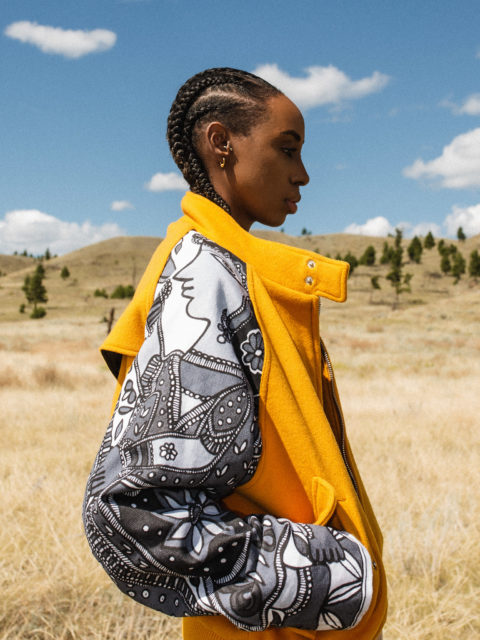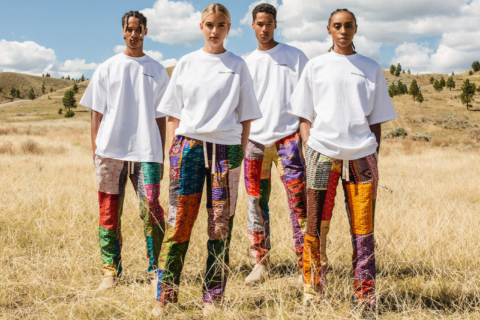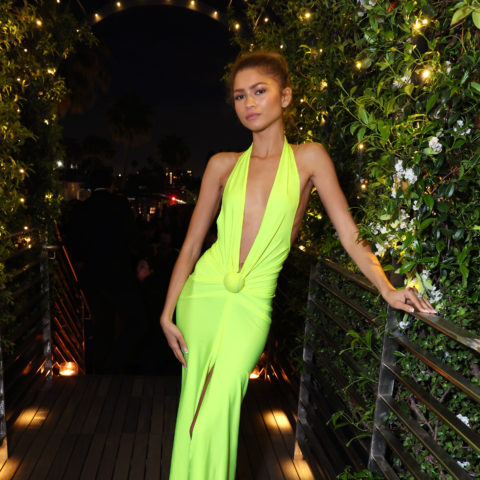Vancouver Brand Sevin Kasran Drops a New Collection Today
New pieces feature upcycled elements and boast an ungendered approach to design.
When Kevin Klover and Sunny Basran launched their Vancouver-based brand Sevin Kasran, they were coming at it from the position of being fashion fans but design outsiders. Neither have formal training, but through a mutual love of style, a shared admiration for the rich garment history and artistic motifs of their backgrounds, and a desire to unify people through the power of dressing, the’ve come to craft pieces that resonate with both everyday citizens and the sporting elite.
Sevin Kasran’s newest ungendered collection features the use of upcycled fabrics from saris, and sees favourite elements from their first collection reiterated in items like the Turmeric bomber jacket. “The silhouette is inspired by our grandparents and the oversized wool pieces they’d wear everywhere and have forever,” says Basran of the garment. Its eye-catching hue pays homage to the spice the duo’s parents would cook with, and the pattern on the sleeves reference Indian silk art.
It’s this fusion of forward-thinking and reverential nostalgia that make Sevin Kasran’s wares into instant wardrobe staples. “We don’t want to release a bunch of collections every year despite how big we get,” notes Klover. “We really strive to make our collections wearable for a long time.”

How did you develop this brand? Do you have a background in fashion design?
Klover: We met through friends and doing sports, and through talking about things like fashion, sports and music, we built a relationship between us. From there, we hung out a lot and wanted to create a brand. I went to school for graphic design; I knew the computer side of creating visuals but from the pattern-making side and production side, we were brand new to it and just learned along the way.
Basran: We’re obviously not from the traditional wave of fashion designers; I’d say we’re from the newer wave of youth culture. My background is in art and literature; Kevin handles more of the technical side of the business and I do the storytelling and figuring out how we incorporate that into every collection we do. Our brand is like a personal conversation between us that gets showcased in a product. Then these products represent a larger idea that we want to evoke in people. As designers, we want to tell stories and open doors for the next generation. That’s really important for us, because we don’t often see people like us doing things like this.
Do you think not having formal fashion training might have benefitted you in launching the brand?
Klover: I think it helped us a lot, even just by teaching us persistence and getting some grit on us. But there are no rules that we go by. In the beginning it was hard – we didn’t have any resources and didn’t know how to make garments. But we learned so much through failures and tried doing things so many different ways. Not knowing anything was a blessing because we were schooled through doing and trying. And we just kept going and now have a lot of confidence in the brand.
Basran: I reflect on this a lot. I like using the term of ‘blissful ignorance’ – I know my personality, and I couldn’t survive in a realm of doing things in a [certain] way. I think sitting at a desk and being told what to do suppresses creativity. I mean, knowing how to sew would’ve been nice, but we created a partnership and had an end goal in mind. I wouldn’t have done it another way; we traveled to Italy and America together and just figured things out. There’s a stigma that ‘everyone’ can be a fashion designer, but not everyone works hard on their craft and hones a proper message. We’re not in this to be the next big thing; we want to take care of our families, and we have a civil duty to spread our message, to let a younger generation know that they can also do it.
Klover: School also doesn’t give someone the perfect, golden path towards success either. We’re from a smaller city called Kamloops; we want to show people in our culture, and every culture, what’s possible through learning and perseverance. We literally started from nothing. We figured it out, and we’re still figuring it out.

Tell me about why you decided to incorporate upcycling into this new collection.
Klover: We’re both very aware of the environmental problems in the fashion industry. We’re new, and upcycling is hard for a smaller brand, but we want to use the resources that we have to get into that practice as much as possible. Anyone can do it if they really want to. This collection features our first upcycled pieces and we’re really proud of it – especially given the fabrics we got to use. We always used to watch our moms wearing their saris, and we joked and would say, why do you only wear these nice, expensive pieces once?
Let’s go back to your mention of sports; quite a few sports figures have worn your pieces. What does it mean to you to have their support?
Klover: The NBA is a huge part of our lives. Talking about sports brings us together with others. And it’s also something that brought Sunny and I together. Our first dreams were hoop dreams; we wanted to be basketball players. We didn’t end becoming them but this is the next best thing. Seeing someone like Kyle Kuzma wearing our Gandhi sweat suit – the fact that an African-American basketball star can wear that piece – that’s why do this. This is the movement we wanted to create with the collection, [and] he obviously felt it.
Basran: These athletes are the kind of people we get our inspiration from, and the tunnel as become a runway. It makes what’s happening feel like a big potluck instead of it being like, sports and music and fashion are separated. Our brand is trying to accomplish this feeling of unity.
You showed during Vancouver Fashion Week in 2018. Do you think fashion shows are still relevant? And what are you doing now as a brand to communicate your ethos and show your new collection, given the fact that fashion weeks have changed so much this year?
Basran: Fashion shows in general serve their purpose and I think they should stick around. Tradition is a good thing – in our culture, we have traditions. Everybody has them. Going back to VFW, we were just like, this is what you do. We worked really hard to get the pieces together and present. But with COVID happening and forcing everyone to go online means that everyone has to be more creative and more resourceful, and hone a message that will really impact people. I think the cream will rise to the top. And I love that the narrative is changing and that things aren’t being done in a cookie-cutter way; you don’t have to do things the same way to be cool or relevant. I feel like consumers are different now, too. They want to see something with meaning and latch on to something with substance.
Klover: The overall experience of VFW was so fun. My favourite thing growing up was playing basketball or soccer, and the feeling of butterflies before a game. The feeling before [our] fashion show almost exceeded that; we looked at each other before the pieces went out and were like, whoa, this is pretty crazy. And when we walked out and people were clapping and we got an awesome response. I hadn’t felt like that in a long time. Our goal is to one day go to Paris and show a collection, but it’s not our be all, end all. We love history and want to pay our dues in that way, but we know there are other ways to show our work. We have a lot of pride in our videos and storytelling.








